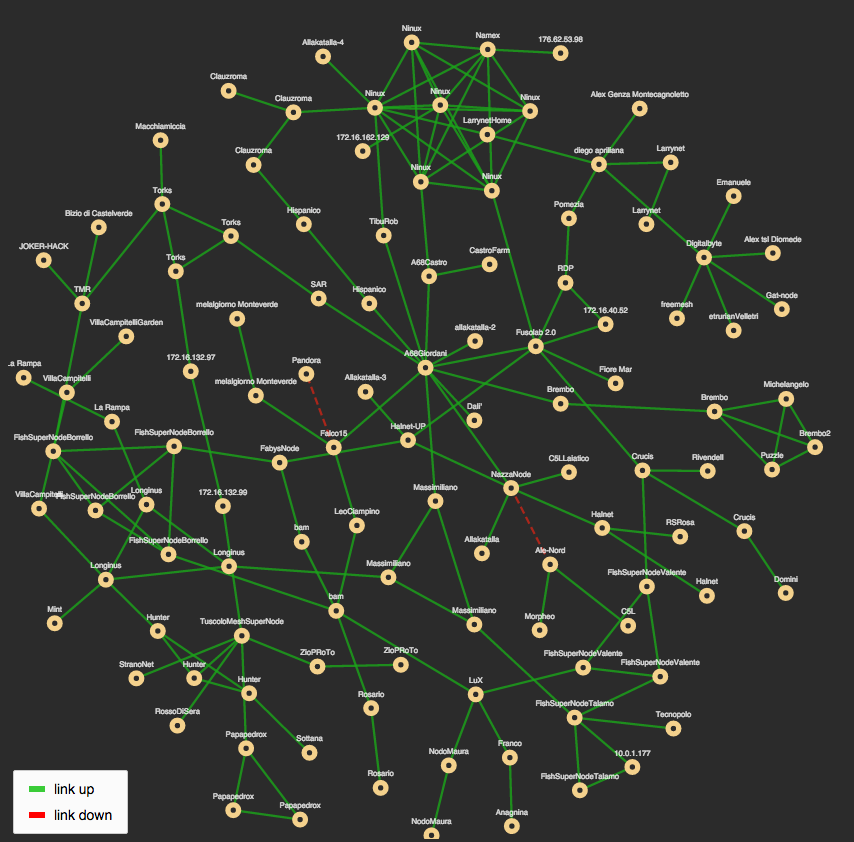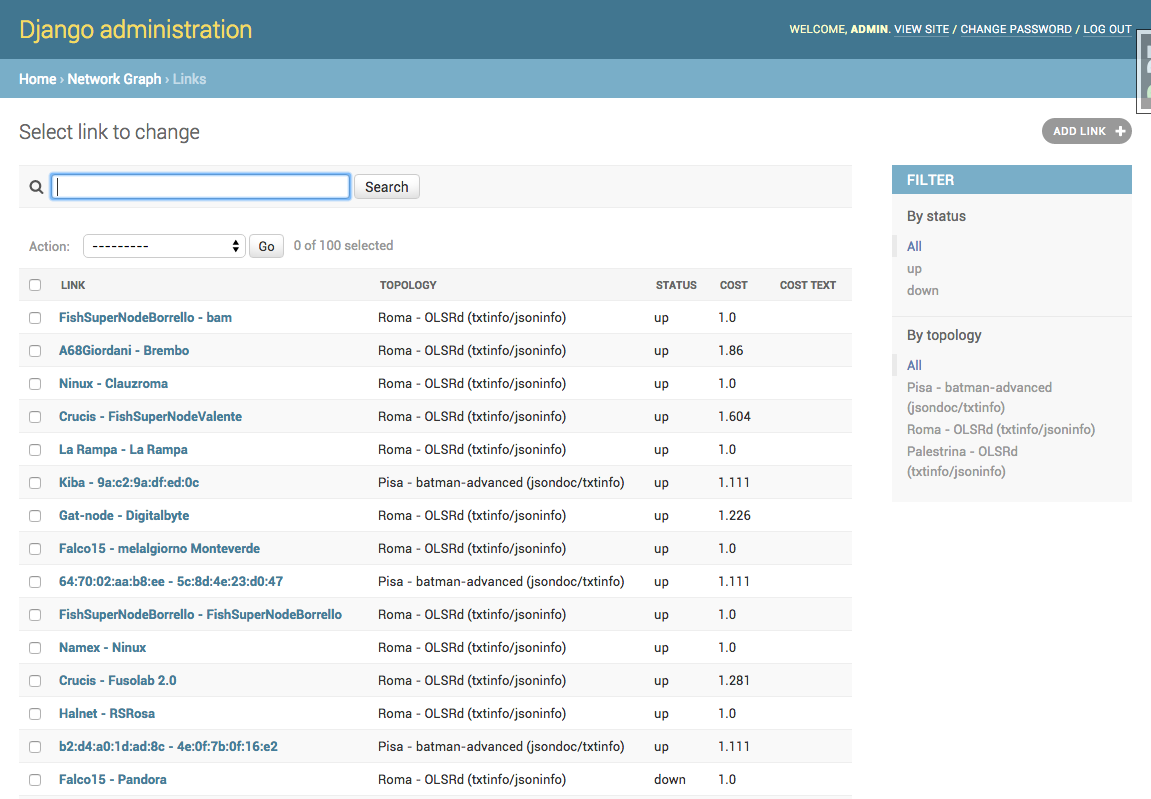Reusable django app for collecting and visualizing network topology
Project description





Reusable django app for collecting and visualizing network topology.


Current features
- network topology collector supporting different formats:
NetJSON NetworkGraph
OLSR (jsoninfo/txtinfo)
batman-adv (jsondoc/txtinfo)
BMX6 (q6m)
CNML 1.0
OpenVPN
additional formats can be added by specifying custom parsers
network topology visualizer based on netjsongraph.js
simple HTTP API that exposes data in NetJSON NetworkGraph format
admin interface that allows to easily manage, audit, visualize and debug topologies and their relative data (nodes, links)
receive topology from multiple nodes
topology history: allows saving daily snapshots of each topology that can be viewed in the frontend
Project goals
make it easy to visualize network topology data for the formats supported by netdiff
expose topology data via RESTful resources in NetJSON NetworkGraph format
make it easy to integrate in larger django projects to improve reusability
make it easy to extend its models by providing abstract models (needs improvement in this point)
provide ways to customize or replace the visualizer (needs improvement in this point)
keep the core very simple
provide ways to extend the default behaviour
encourage new features to be published as extensions
Deploy it in production
An automated installer is provided by the OpenWISP project: ansible-openwisp2.
Ensure to follow the instructions explained in the following section: Enabling the network topology module.
Install stable version from pypi
Install from pypi:
pip install django-netjsongraphInstall development version
Install tarball:
pip install https://github.com/openwisp/django-netjsongraph/tarball/masterAlternatively you can install via pip using git:
pip install -e git+git://github.com/openwisp/django-netjsongraph#egg=django-netjsongraphIf you want to contribute, install your cloned fork:
git clone git@github.com:<your_fork>/django-netjsongraph.git
cd django-netjsongraph
python setup.py developSetup (integrate in an existing django project)
Add rest_framework and django_netjsongraph to INSTALLED_APPS:
INSTALLED_APPS = [
# other apps
'rest_framework',
'openwisp_utils.admin_theme',
'django_netjsongraph'
# ...
]Include urls in your urlconf (you can change the prefixes according to your needs):
from django.conf.urls import include, url
from django_netjsongraph.api import urls as netjsongraph_api
from django_netjsongraph.visualizer import urls as netjsongraph_visualizer
urlpatterns = [
# your URLs ...
url(r'^api/', include(netjsongraph_api)),
url(r'', include(netjsongraph_visualizer)),
]Create database tables:
./manage.py migrate
Management Commands
update_topology
After topology URLs (URLs exposing the files that the topology of the network) have been added in the admin, the update_topology management command can be used to collect data and start playing with the network graph:
./manage.py update_topology
The management command accepts a --label argument that will be used to search in topology labels, eg:
./manage.py update_topology --label mytopology
save_snapshot
The save_snapshot management command can be used to save the topology graph data which could be used to view the network topology graph sometime in future:
./manage.py save_snapshot
The management command accepts a --label argument that will be used to search in topology labels, eg:
./manage.py save_snapshot --label mytopology
Logging
The update_topology management command will automatically try to log errors.
For a good default LOGGING configuration refer to the test settings.
Strategies
There are mainly two ways of collecting topology information:
FETCH strategy
RECEIVE strategy
Each Topology instance has a strategy field which can be set to the desired setting.
FETCH strategy
Topology data will be fetched from a URL.
When some links are not detected anymore they will be flagged as “down” straightaway.
RECEIVE strategy
Topology data is sent directly from one or more nodes of the network.
The collector waits to receive data in the payload of a POST HTTP request; when such a request is received, a key parameter it’s first checked against the Topology key.
If the request is authorized the collector proceeds to update the topology.
If the data is sent from one node only, it’s highly advised to set the expiration_time of the Topology instance to 0 (seconds), this way the system works just like in the FETCH strategy, with the only difference that the data is sent by one node instead of fetched by the collector.
If the data is sent from multiple nodes, you SHOULD set the expiration_time of the Topology instance to a value slightly higher than the interval used by nodes to send the topology, this way links will be flagged as “down” only if they haven’t been detected for a while. This mechanism allows to visualize the topology even if the network has been split in several parts, the disadvantage is that it will take a bit more time to detect links that go offline.
Settings
NETJSONGRAPH_PARSERS
type: |
list |
default: |
[] |
Additional custom netdiff parsers.
NETJSONGRAPH_SIGNALS
type: |
str |
default: |
None |
String representing python module to import on initialization.
Useful for loading django signals or to define custom behaviour.
NETJSONGRAPH_TIMEOUT
type: |
int |
default: |
8 |
Timeout when fetching topology URLs.
NETJSONGRAPH_LINK_EXPIRATION
type: |
int |
default: |
60 |
If a link is down for more days than this number, it will be deleted by the update_topology management command.
Setting this to False will disable this feature.
NETJSONGRAPH_VISUALIZER_CSS
type: |
str |
default: |
netjsongraph/css/style.css |
Path of the visualizer css file. Allows customization of css according to user’s preferences.
NETJSONGRAPH_NODE_EXPIRATION
type: |
int |
default: |
False |
If a node has not been modified since the days specified and if it has no links, it will be deleted by the update_topology management command. This depends on NETJSONGRAPH_LINK_EXPIRATION being enabled. Replace False with an integer to enable the feature.
TOPOLOGY_RECEIVE_URLCONF
type: |
string |
default: |
None |
Use the urlconf option to change receive api url to point to another module, example, myapp.urls.
TOPOLOGY_RECEIVE_BASEURL
type: |
string |
default: |
None |
If you have a seperate instanse of django-netjsongraph to which you want to point your receive url to, you can use this option to change the base of the url, example: https://mytopology.myapp.com.
Overriding visualizer templates
Follow these steps to override and customise the visualizer’s default templates:
create a directory in your django project and put its full path in TEMPLATES['DIRS'], which can be found in the django settings.py file
create a sub directory named netjsongraph and add all the templates which shall override the default netjsongraph/* templates
create a template file with the same name of the template file you want to override
More information about the syntax used in django templates can be found in the django templates documentation.
Example: overriding the <script> tag
Here’s a step by step guide on how to change the javascript options passed to netjsongraph.js, remember to replace <project_path> with the absolute filesytem path of your project.
Step 1: create a directory in <project_path>/templates/netjsongraph
Step 2: open your settings.py and edit the TEMPLATES['DIRS'] setting so that it looks like the following example:
# settings.py
TEMPLATES = [
{
'DIRS': [os.path.join(BASE_DIR, 'templates')],
# ... all other lines have been omitted for brevity ...
}
]Step 3: create a new file named netjsongraph-script.html in the new <project_path>/templates/netjsongraph/ directory, eg:
<!-- <project_path>/templates/netjsongraph/netjsongraph-script.html -->
<script>
window.__njg_el__ = window.__njg_el__ || "body";
window.__njg_default_url__ = "{{ graph_url }}";
window.loadNetJsonGraph = function(graph){
graph = graph || window.__njg_default_url__;
d3.select("svg").remove();
d3.select(".njg-overlay").remove();
d3.select(".njg-metadata").remove();
return d3.netJsonGraph(graph, {
el: window.__njg_el__,
// customizations of netjsongraph.js
linkClassProperty: "status",
defaultStyle: false,
labelDy: "-1.4em",
circleRadius: 8,
charge: -100,
gravity: 0.3,
linkDistance: 100,
linkStrength: 0.2,
});
};
window.graph = window.loadNetJsonGraph();
window.initTopologyHistory(jQuery);
</script>Extending django-netjsongraph
django-netjsongraph provides a set of models, admin classes and generic views which can be imported, extended and reused by third party apps.
To extend django-netjsongraph, you MUST NOT add it to settings.INSTALLED_APPS, but you must create your own app (which goes into settings.INSTALLED_APPS), import the base classes from django-netjsongraph and add your customizations.
Extending models
This example provides an example of how to extend the base models of django-netjsongraph.
# models.py of your custom ``network`` app
from django.db import models
from django_netjsongraph.base.link import AbstractLink
from django_netjsongraph.base.node import AbstractNode
from django_netjsongraph.base.snapshot import AbstractSnapshot
from django_netjsongraph.base.topology import AbstractTopology
# the model ``organizations.Organization`` is omitted for brevity
# if you are curious to see a real implementation, check out django-organizations
# https://github.com/bennylope/django-organizations
class OrganizationMixin(models.Model):
organization = models.ForeignKey('organization.Organization')
class Meta:
abstract = True
class Topology(OrganizationMixin, AbstractTopology):
def clean(self):
# your own validation logic here
pass
class Meta(AbstractTopology.Meta):
abstract = False
class Node(AbstractNode):
topology = models.ForeignKey('Topology')
class Meta:
abstract = False
class Link(AbstractLink):
topology = models.ForeignKey('Topology')
source = models.ForeignKey('Node',
related_name='source_link_set')
target = models.ForeignKey('Node',
related_name='source_target_set')
class Meta:
abstract = False
class Snapshot(OrgMixin, AbstractSnapshot):
topology = models.ForeignKey('topology.Topology', on_delete=models.CASCADE)
class Meta(AbstractSnapshot.Meta):
abstract = FalseExtending the admin
Following the above example, you can avoid duplicating the admin code by importing the base admin classes and registering your models with.
# admin.py of your app
from django.contrib import admin
from django_netjsongraph.base.admin import (AbstractLinkAdmin,
AbstractNodeAdmin,
AbstractTopologyAdmin)
# these are you custom models
from .models import Link, Node, Topology
class TopologyAdmin(AbstractTopologyAdmin):
model = Topology
class NodeAdmin(AbstractNodeAdmin):
model = Node
class LinkAdmin(AbstractLinkAdmin):
model = Link
admin.site.register(Link, LinkAdmin)
admin.site.register(Node, NodeAdmin)
admin.site.register(Topology, TopologyAdmin)Extending API views
If your use case doesn’t vary much from the base, you may also want to try to reuse the API views:
# your app.api.views
from ..models import Snapshot, Topology
from django_netjsongraph.api.generics import (BaseNetworkCollectionView, BaseNetworkGraphHistoryView,
BaseNetworkGraphView, BaseReceiveTopologyView)
class NetworkCollectionView(BaseNetworkCollectionView):
queryset = Topology.objects.filter(published=True)
class NetworkGraphView(BaseNetworkGraphView):
queryset = Topology.objects.filter(published=True)
class ReceiveTopologyView(BaseReceiveTopologyView):
model = Topology
class NetworkGraphHistoryView(BaseNetworkGraphHistoryView):
topology_model = Topology
snapshot_model = Snapshot
network_collection = NetworkCollectionView.as_view()
network_graph = NetworkGraphView.as_view()
network_graph_history = NetworkGraphHistoryView.as_view()
receive_topology = ReceiveTopologyView.as_view()API URLs
If you are not making drastic changes to the api views, you can avoid duplicating the URL logic by using the get_api_urls function. Put this in your api urls.py:
# your app.api.urls
from django_netjsongraph.utils import get_api_urls
from . import views
urlpatterns = get_api_urls(views)Extending Visualizer Views
If your use case doesn’t vary much from the base, you may also want to try to reuse the Visualizer views:
# your app.visualizer.views
from ..models import Topology
from .generics import BaseTopologyDetailView, BaseTopologyListView
class TopologyListView(BaseTopologyListView):
topology_model = Topology
class TopologyDetailView(BaseTopologyDetailView):
topology_model = Topology
topology_list = TopologyListView.as_view()
topology_detail = TopologyDetailView.as_view()Visualizer URLs
If you are not making any drastic changes to visualizer views, you can avoid duplicating the URL logic by using get_visualizer_urls function. Put this in your visualizer urls.py
# your app.visualizer.urls
from django_netjsongraph.utils import get_visualizer_urls
from . import views
urlpatterns = get_visualizer_urls(views)Extending AppConfig
You may want to reuse the AppConfig class of django-netjsongraph too:
from django_netjsongraph.apps import DjangoNetjsongraphConfig
class MyOwnConfig(DjangoNetjsongraphConfig):
name = 'yourapp'
label = 'yourapp'Installing for development
Install sqlite:
sudo apt-get install sqlite3 libsqlite3-devInstall your forked repo:
git clone git://github.com/<your_fork>/django-netjsongraph
cd django-netjsongraph/
python setup.py developInstall test requirements:
pip install -r requirements-test.txtCreate database:
cd tests/
./manage.py migrate
./manage.py createsuperuserLaunch development server:
./manage.py runserverYou can access the visualizer at http://127.0.0.1:8000/ and the admin interface at http://127.0.0.1:8000/admin/.
Run tests with:
./runtests.pyContributing
First off, thanks for taking the time to read these guidelines.
Trying to follow these guidelines is important in order to minimize waste and avoid misunderstandings.
Ensure your changes meet the Project Goals
If you found a bug please send a failing test with a patch
If you want to add a new feature, announce your intentions in the issue tracker
Fork this repo and install it by following the instructions in Installing for development
Write code
Write tests for your code
Ensure all tests pass
Ensure test coverage is not under 90%
Document your changes
Send pull request
Changelog
See CHANGES.
License
See LICENSE.
This projects bundles third-party javascript libraries in its source code:
Project details
Release history Release notifications | RSS feed
Download files
Download the file for your platform. If you're not sure which to choose, learn more about installing packages.
Source Distribution
Built Distribution
Hashes for django-netjsongraph-0.6.1.tar.gz
| Algorithm | Hash digest | |
|---|---|---|
| SHA256 | a5b14feee914662de536156371577ccb330b84f83fcb0667cb4f09f765e87bc8 |
|
| MD5 | 76524f28d21a541fa4ad2236de7b758b |
|
| BLAKE2b-256 | 875f6c82839838263938afed3a12e7c0ef8cf2522b1af789b11bc91172b1baf1 |
Hashes for django_netjsongraph-0.6.1-py2.py3-none-any.whl
| Algorithm | Hash digest | |
|---|---|---|
| SHA256 | d5aae92f7ec985b024566dff4a9f70a692388563f41d44a8f01f4a89b2987054 |
|
| MD5 | 2ebfd0249db6c18ee2448065063d4fa5 |
|
| BLAKE2b-256 | dd2cbb5198ed52deaf68acc44d815137b9156f4f23393fdd348770111c91087c |













